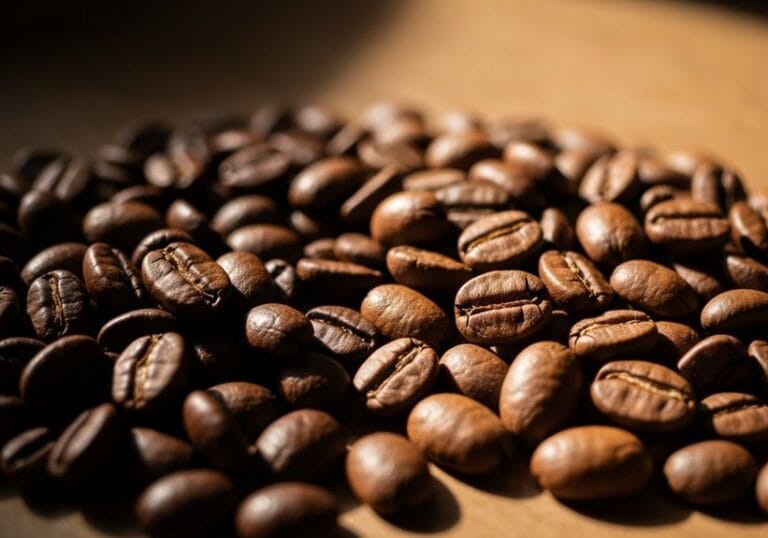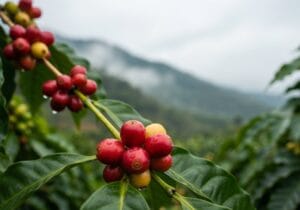So, dark roast and medium roast coffee, huh? They’re like the siblings of the coffee world! Medium roast has that sweet, smooth vibe with notes of caramel and nuts, while dark roast goes bold, smokier, maybe even a little intense—like a coffee with a chip on its shoulder! Caffeine-wise, medium roasts pack a bit more by weight, but dark roasts score higher in extraction (sneaky, right?). Stick around, and you might just find out more about these caffeinated contenders!
Key Takeaways
- Medium roasts offer a balanced sweetness and acidity, while dark roasts provide a bold, smokier flavor profile.
- Medium roasts contain higher chlorogenic acid, beneficial for inflammation and blood sugar control, unlike dark roasts.
- Dark roasts have a higher caffeine content per extraction efficiency, while medium roasts have slightly more caffeine by weight.
- Dark roasts may be gentler on the stomach due to longer roasting times, making them preferable for sensitive stomachs.
- Brewing methods significantly impact coffee flavor and strength; measuring by weight yields more accurate caffeine comparisons between roasts.
Flavor Profiles
Regarding coffee flavor profiles, it’s like stepping into two completely different worlds—one’s a party bursting with flavor while the other’s a bold yet smoky grilling session!
Medium roasts are like that balanced buddy who brings both sweetness and acidity to the table. You get delightful flavor notes like caramel and nuts, and even a hint of fruity flair from the beans’ origins. Medium roasts are known for their smooth body and moderate acidity, making them a favorite for those who enjoy a nuanced coffee experience!
On the flip side, dark roasts are the wild party animal, strutting in with a bolder, smokier vibe, overwhelming some of those unique bean characteristics. Sure, it’s intense, but sometimes, like a bad dance move, it’s a little harsh, hitting you right in the bitter bone!
Caffeine Content
Coffee lovers often find themselves tangled in the caffeinated debate: which roast packs more punch? Surprisingly, it’s not as straightforward as one might think! Dark roasts often get a bad rap, assumed to be caffeine powerhouses due to their bold taste. However, medium roasts actually retain slightly more caffeine because roasting zaps some of it away.
Here’s a quick breakdown of caffeine content by roast:
| Roast Type | Caffeine by Weight (mg) | Extraction Efficiency (%) |
|---|---|---|
| Medium | 520 | 92 |
| Dark | 600 | 95 |
Measuring methods matter! If you scoop instead of weigh, dark roasts might feel weaker because they’re less dense. Additionally, the choice of coffee bean variety can significantly impact brew strength and flavor, further complicating the caffeine content discussion. So, next time, just brew what you love and forget the math!
Health-Related Differences

While caffeine content definitely plays a role in coffee conversations, let’s not overlook another battleground: health!
It turns out, dark and medium roasts are like the ultimate dueling superheroes of the coffee world! Dark roasts come packing antioxidants like glutathione and vitamin E, great for skin health and battling those pesky free radicals.
On the flip side, medium roasts boast higher chlorogenic acid levels, known for lowering inflammation and controlling blood sugar—take that, inflammation!
Medium roasts are champions in the inflammation fight, thanks to their higher chlorogenic acid levels—goodbye, inflammation!
In terms of digestive health, dark roasts might be gentler on the stomach—thank you, longer roasting time! Meanwhile, medium roasts can be a little more acidic, not always the best choice for those with sensitive bellies.
Who knew coffee could be such a health showdown?
Frequently Asked Questions
How Do Brewing Methods Impact Flavor Differences Between Roasts?
Brewing methods considerably influence flavor extraction and brewing time, as dark roasts benefit from immersion techniques enhancing boldness, while medium roasts thrive in methods promoting acidity and sweetness, balancing extraction to showcase distinctive flavor profiles.
Can I Mix Dark and Medium Roast Beans?
Mixing dark and medium roast beans is beneficial for flavor balance; it combines the bold, smoky notes of dark roasts with the bright, fruity characteristics of medium roasts, enhancing complexity and creating a smoother coffee experience.
Which Roast Is Better for Espresso?
Medium roast espresso typically offers a balanced flavor profile, appealing to diverse espresso preferences. While dark roast provides boldness, medium roast highlights complexity and sweetness, making it favorable for those seeking a detailed espresso experience.
How Do Storage Methods Affect Coffee Roast Flavor?
Storage methods greatly impact coffee roast flavor. Ideal storage temperature (65-75°F) in airtight, opaque containers prevents light and humidity exposure, preserving freshness and flavor integrity while minimizing oxidation and staling effects. Properly selecting container type is essential.
What Grind Size Works Best for Each Roast Type?
For ideal extraction, dark roast coffee benefits from coarse grind consistency to reduce bitterness, while medium roast requires medium grind consistency to balance flavors. Both should consider brew time to enhance taste without over-extraction.
References
- https://www.healthline.com/nutrition/light-vs-dark-roast-coffee
- https://nutritionfacts.org/blog/is-light-or-dark-roast-coffee-healthier/
- https://www.honest-rare.de/en/magazine/coffee-resting-differences-light-medium-dark/
- https://coffeehero.com.au/blogs/news/differences-between-light-medium-and-dark-roast-coffee
- https://methodicalcoffee.com/blogs/coffee-culture/what-s-the-difference-between-light-medium-and-dark-roast-coffee





